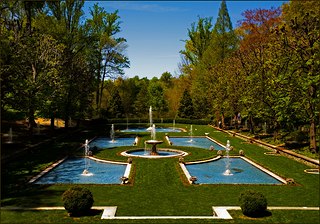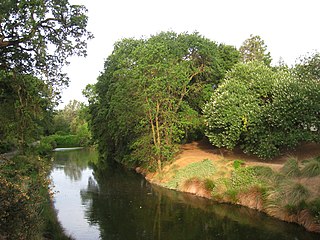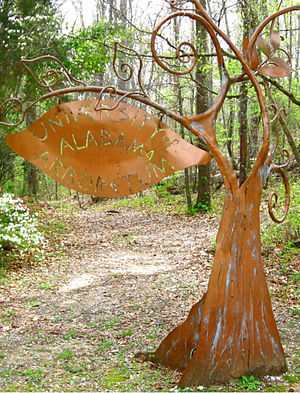
An arboretum is a botanical collection composed exclusively of trees of a variety of species. Originally mostly created as a section in a larger garden or park for specimens of mostly non-local species, many modern arboreta are in botanical gardens as living collections of woody plants and is intended at least in part for scientific study.

Longwood Gardens is a botanical garden that consists of over 1,077 acres of gardens, woodlands, and meadows in Kennett Square, Pennsylvania, United States in the Brandywine Creek Valley. It is one of the premier horticultural display gardens in the United States and is open to visitors year-round to enjoy native and exotic plants and horticulture, events and performances, seasonal and themed attractions, as well as educational lectures, courses, and workshops.

The Arnold Arboretum of Harvard University is a botanical research institution and free public park, located in the Jamaica Plain and Roslindale neighborhoods of Boston, Massachusetts. Established in 1872, it is the oldest public arboretum in North America. The landscape was designed by Charles Sprague Sargent and Frederick Law Olmsted and is the second largest "link" in the Emerald Necklace. The Arnold Arboretum's collection of temperate trees, shrubs, and vines has an emphasis on the plants of the eastern United States and eastern Asia, where arboretum staff and colleagues are sourcing new material on plant collecting expeditions. The arboretum supports research in its landscape and in its Weld Hill Research Building.

The Bartlett Arboretum and Gardens in Stamford, Connecticut, contains 93 acres of parkland, gardens, landscapes, and hiking trails that focus on the regional plants, ecology and character of Southwestern New England. The Arboretum is open and accessible to the public every day of the year and is located at 151 Brookdale Road.

The Arboretum, State Botanical Garden of Kentucky, 40 hectares or 100 acres (0.40 km2), is located at the University of Kentucky in Lexington, Kentucky, United States. It is open to the public from dawn to dusk every day of the year. The Arboretum hosts 18 tree species native to Kentucky, as well as 80 other native Kentucky plant species. In total, the Arboretum contains more than 1,200 native species.

Red Butte Garden and Arboretum consists of a botanical garden, arboretum, and amphitheatre operated by the University of Utah, in the foothills of the Wasatch Range in Salt Lake City, Utah, United States. It is open year-round to the public. Red Butte Garden contains over 100 acres (0.40 km2) of botanical gardens and several miles of hiking trails through native vegetation. Red Butte Creek runs within the northern part of the garden.

The University of California, Davis Arboretum is an approximately 100-acre (0.40 km2) arboretum along the banks of the old north channel of Putah Creek on the south side of the University of California, Davis campus in unincorporated Yolo County, California, in the United States.

The Birmingham Botanical Gardens is 67.5-acre (27.3 ha) of botanical gardens located adjacent to Lane Park at the southern foot of Red Mountain in Birmingham, Alabama. The gardens are home to over 12,000 different types of plants, 25 unique gardens, more than 30 works of original outdoor sculpture, and several miles of walking paths. With more than 350,000 annual visitors, the Birmingham Botanical Gardens qualify as one of Alabama's top free-admittance tourist attractions. The Birmingham Botanical Gardens is also a part of the American Public Gardens Association.

The Mobile Botanical Gardens were founded in 1974, and are located on Museum Drive in the Spring Hill community in Mobile, Alabama, United States.

The Donald E. Davis Arboretum, in Auburn, Alabama, United States, is a public native plants museum, and botanical arboretum with educational facilities, event spaces, and a conservation program. Its grounds, covering 13.5 acres of Auburn University's campus, include cataloged living collections of associated tree and plant communities representative of Alabama's ecosystems, among which is mixed oak forest, carnivorous bog, and longleaf pine savanna. The living collections include more than 1,000 plant types, including 500 different plant species, with over 3,000 cataloged specimens. The Arboretum contains over a mile (2 km) of interwoven walking trails that meander through various southeastern biotopes.

The Arizona Cactus Garden, or, officially, Arizona Garden, also known as the Cactus Garden, is a small botanical garden specializing in cactus and succulents. It is located on the campus of Stanford University, in Stanford, California, US. It is open to the public daily without charge.

Hoyt Arboretum is a public park in Portland, Oregon, which is part of the complex of parks collectively known as Washington Park. The 189-acre (76 ha) arboretum is located atop a ridge in the Tualatin Mountains two miles (3.2 km) west of downtown Portland. Hoyt has 12 miles of hiking trails, two miles of accessible paved trails, and is open free to the public all year. About 350,000 visitors per year visit the arboretum.

The University of Wisconsin–Madison Arboretum is a teaching and research facility of the University of Wisconsin–Madison and the site of historic research in ecological restoration. In addition to its 1,260 acres (5 km2) in Madison, Wisconsin, the Arboretum also manages 520 acres (210 ha) of remnant forests and prairies throughout Wisconsin. It was designated a National Historic Landmark in 2021, in recognition for its role as a pioneer in the field of ecological restoration.

Chadwick Arboretum is a 62 acres (25 ha) arboretum on the Agriculture campus of The Ohio State University, in Columbus, Ohio, United States. The main arboretum collection is located just across Lane Avenue from the Schottenstein Center with its other collections nearby. The arboretum is open daily without charge.

The University of Guelph Arboretum is an arboretum organized by the University of Guelph in Guelph, Ontario. It was formally established in 1970 by the university and aims to conserve biodiversity and connect people with nature through teaching, research, and community outreach. The space is 165 hectares and is open throughout the year.

The Berlin Botanic Garden and Botanical Museum is a botanical garden in the Lichterfelde locality of the borough of Steglitz-Zehlendorf, Berlin, Germany. Constructed between 1897 and 1910 under the guidance of architect Adolf Engler, it has an area of 43 hectares [ha] and around 22,000 different plant species. The garden is part of the Free University of Berlin.

The North Carolina Botanical Garden is a botanical garden operated by the University of North Carolina at Chapel Hill in Chapel Hill, North Carolina. The primary goal of the Garden is to research, catalog, and promote the native plant species of North Carolina.

The Arboretum at Penn State, which contains the H.O. Smith Botanic Gardens, is a new arboretum at The Pennsylvania State University adjacent to its University Park campus in State College, Pennsylvania. It is Penn State's second arboretum, joining the Arboretum at Penn State Behrend, which was created in 2003.

Carya pallida, sand hickory, or pale hickory is a species of hickory native to the southeastern United States. It is a perennial, dicotyledonous plant which prefers rocky or sandy habitats. The sand hickory can reach heights of up to 30m, but its typical height is between 9-24m. In an open area, Carya crowns are usually towering and slim. The sand hickory nut is edible and consumed by various organisms.





















